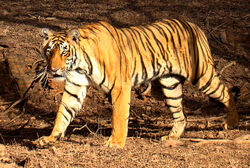(Adding categories) |
(Adding categories) |
||
| Line 81: | Line 81: | ||
[[Category:The Mighty Jungle (Canadian TV Series) Animals]] |
[[Category:The Mighty Jungle (Canadian TV Series) Animals]] |
||
[[Category:Zoobabu Animals]] |
[[Category:Zoobabu Animals]] |
||
| + | [[Category:Sing Animals]] |
||
Revision as of 12:10, 12 October 2019
| Tiger | |
|---|---|
 Bengal Tiger | |
| Information | |
| Range | Asia |
| Scientific Classification | |
| Kingdom | Animalia |
| Conservation Status | |
 Endangered | |
The Tiger is a species from the of Panthera genus, native to much of eastern and southern Asia.
Appearance
The tiger is an apex predator and an obligate carnivore. Reaching up to 3.3 metres (11 ft) in total length and weighing up to 300 kilograms (660 pounds), the larger tiger subspecies are comparable in size to the biggest extinct felids. Aside from their great bulk and power, their most recognizable feature is the pattern of dark vertical stripes that overlays near-white to reddish-orange fur, with lighter underparts. The most numerous tiger subspecies is the Bengal tiger while the largest subspecies is the Siberian tiger.
Behavior
Highly adaptable, tigers range from the Siberian taiga, to open grasslands, to tropical mangrove swamps. They are territorial and generally solitary animals, often requiring large contiguous areas of habitat that support their prey demands. This, coupled with the fact that they are endemic to some of the more densely populated places on earth, has caused significant conflicts with humans. Of the nine subspecies of modern tiger, three are extinct and the remaining six are classified as endangered, some critically so. The primary direct causes are habitat destruction and fragmentation, and hunting. Their historical range, which once reached from Mesopotamia and the Caucasus through most of South and East Asia, has been radically reduced. While all surviving species are under formal protection, poaching, habitat destruction and inbreeding depression continue to be threats. Tigers are mainly found in the countries of India, Nepal, China, and eastern Russia.
Diet
Tigers are carnivores, meaning they eat meat. They will typically eat things like wild pigs, gnu, chicken, rhinos, or antelope. But they wouldn't be able to eat any of these if it wasn't for their fur. The orange (and sometimes tan) and black pattern allows them to easily hide in tall grasses and await prey to wander by. When prey does come near, the tiger stalks them for 20-30 minutes. After that, they attack. They go for the neck and sink their large teeth into the animals neck, instantly killing it. The tiger than eats until they cannot eat anymore. If there are any leftovers, they hide them under grasses and dirt until they are hungry again, then they will return for a snack. Because tigers save their food, they only need to hunt once or twice a week.
Lifespan
Tigers live anywhere from 15 to 20 years. They can give birth to 7 babies at once, and the babies usually weight around 2.2 pounds.
Gallery

Japanese Blue Tiger (rare footage)-0

National Geographic Live! - Robot vs. Tiger
Facts
- The Tiger's unique color allows it to hide in tall grasses and await prey.
- Tigers do not hunt until they are 2 years old.
- Tigers are great swimmers.
- Tigers are the largest and strongest of all big cats.
- A tigers front teeth are 4 inches long.
- Half of all tigers left in the world are Bengal Tigers.
- Tigers can eat 100 pounds of food in one sitting. That would be if we ate 400 hamburgers in one sitting.
- A tigers skin has stripes just like its fur.
The pattern of stripes is unique to each animal, these unique markings can be used by researchers to identify individuals (both in the wild and captivity), much in the same way that fingerprints are used to identify humans. It seems likely that the function of stripes is camouflage, serving to help tigers conceal themselves amongst the dappled shadows and long grass of their environment as they stalk their prey. The stripe pattern is also found on the skin of the tiger. If a tiger were to be shaved, its distinctive camouflage pattern would be preserved.
Tigers are the most variable in size of all big cats, even more so than leopards and much more so than lions.[1] The Bengal, Caspian and Siberian tiger subspecies represent the largest living felids, and rank among the biggest felids that ever existed. An average adult male tiger from Northern India or Siberia outweighs an average adult male lion by around Template:Convert.[1] Females vary in length from Template:Convert, weigh Template:Convert with a greatest length of skull ranging from Template:Convert. Males vary in size from Template:Convert, weigh Template:Convert with a greatest length of skull ranging from Template:Convert.[2] Body size of different populations seems to be correlated with climate—Bergmann's Rule—and can be explained from the point of view of thermoregulation.[3] Large male Siberian tigers can reach a total length of more than Template:Convert "over curves", Template:Convert "between pegs" and a weight of Template:Convert. This is considerably larger than the size reached by the smallest living tiger subspecies, the Sumatran tiger, which reach a body weight of Template:Convert. Of the total length of a tiger, the tail comprises Template:Convert.[4][5] At the shoulder, tigers may variously stand Template:Convert tall.[6] The accepted record weight, per the Guinness Book of World Records, for a wild tiger was Template:Convert for a Bengal tiger shot in 1967, though its weight may have been boosted by the fact that it had eaten a water buffalo the previous night.[7][8]
Tigresses are smaller than the males in each subspecies, although the size difference between male and female tigers tends to be more pronounced in the larger tiger subspecies, with males weighing up to 1.7 times more than the females.[9] In addition, male tigers have wider forepaw pads than females. Biologists use this difference to determine gender based on tiger tracks.[10] The skull of the tiger is very similar to that of the lion, though the frontal region is usually not as depressed or flattened, with a slightly longer postorbital region. The skull of a lion has broader nasal openings. However, due to the amount of skull variation in the two species, usually, only the structure of the lower jaw can be used as a reliable indicator of species.[11]
Subspecies
There are currently two subspecies, the Mainland Asian Tiger (consisting of the Bengal Tiger, Caspian Tiger (extinct), Indochinese Tiger, Malayan Tiger, Siberian Tiger, South China Tiger, and the Wanhsien Tiger (extinct), being the largest and most numerous, and the Sunda Island Tiger (consisting of the Bali Tiger (extinct), Javan Tiger (extinct), Ngandong Tiger (extinct), Sumatran Tiger, and Trinil Tiger (extinct).
- ↑ 1.0 1.1 Template:Cite book
- ↑ Carnivores of the World by Dr. Luke Hunter. Princeton University Press (2011), IBSN 9780691152288
- ↑ Cite error: Invalid
<ref>tag; no text was provided for refs namedMazak1981 - ↑ Retrieved 2011-07-25|Tiger. The Animal Files. 1937-09-27
- ↑ Tigers. Physical Characteristics and Special Adaptations. seaworld.org
- ↑ Cite error: Invalid
<ref>tag; no text was provided for refs namedder-tiger - ↑ Template:Cite book
- ↑ The Object at Hand | Science & Nature | Smithsonian Magazine. Smithsonianmag.com (2012-03-16). Retrieved on 2012-07-28.
- ↑ Template:Cite book
- ↑ Cite error: Invalid
<ref>tag; no text was provided for refs namedTigersnow - ↑ Geptner, V. G., Sludskii, A. A. (1972) Mlekopitaiuščie Sovetskogo Soiuza. Vysšaia Škola, Moskva. (In Russian; English translation: Heptner, V. G.; Sludskii, A. A.; Bannikov, A. G.; (1992) Mammals of the Soviet Union. Volume II, Part 2: Carnivora (Hyaenas and Cats). Smithsonian Institute and the National Science Foundation, Washington DC). pp. 95–202.









